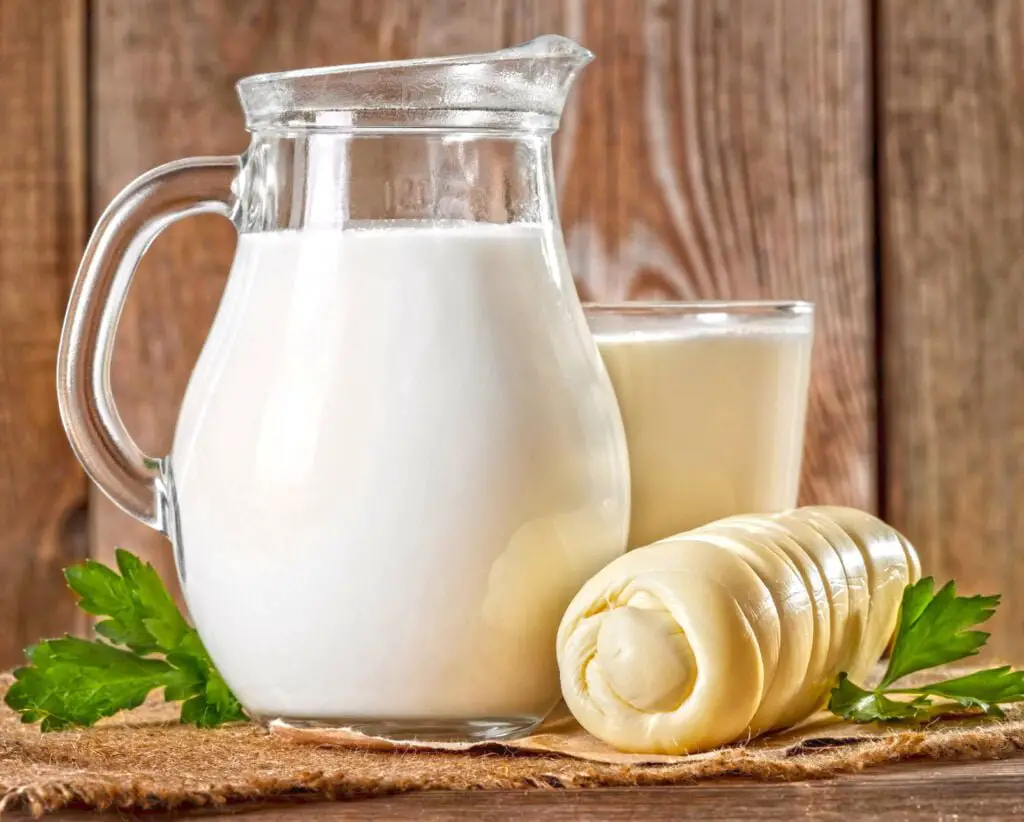Milk is the oldest natural beverage, and it is mainly squeezed from female cows. In different countries, milk is also divided into different grades. Milk is rich in minerals, calcium, phosphorus, iron, zinc, copper, manganese, and molybdenum. The rarest thing is that milk is the best source of calcium for the human body, and the proportion of calcium and phosphorus is very appropriate conducive to calcium absorption.
The species of milk are complex, with at least more than 100 kinds. The main components are water, fat, phospholipids, protein, lactose, inorganic salts, etc. There are different types of milk. Let’s have a look at the difference between whole milk and skimmed milk.
Classification of milk
Low-fat milk
According to the different fat content of milk, milk can be divided into whole milk (fat content is 3.5% – 4.5%), semi-skimmed milk (1.0% – 3.5%), and skimmed milk (generally less than 0.04%).
If we drink 250ml whole milk every time, its fat will bring us about 80kcal of calories (which can be consumed after walking for more than ten minutes), accounting for more than 10% of the fat everyone needs every day. If you add 150ml yogurt in the afternoon tea time, you can not underestimate these calories if you are trying to maintain a perfect figure! Therefore, low-fat milk or skimmed milk is often preferred by girls.
However, the most effective ingredient in milk is fat. As the most complex lipid substance in composition and structure, milk fat carries the rich connotation of more than 400 kinds of fatty acids, giving the milk a rich and unique aroma and full and mellow taste.
Therefore, the milk that takes off the milk fat will be relatively tasteless. Even adding a portion of the food flavor is not enough to fully experience the smell and taste of whole milk. However, while getting rid of fat, fat-soluble vitamins in milk have to be buried, and vitamin D bears the brunt.
Low lactose milk
Dare you drink a whole glass of milk in one breath? Is your stomach beginning to rumble? Hey, hey, don’t worry, you’re not alone!
Most Asian adults are more or less lactose intolerant. In fact, since weaning, our ability to synthesize lactase has begun to deteriorate, and our ability to decompose lactose has also decreased. As a result, lactose trapped in the intestine is broken down by bacteria, producing a large amount of gas, resulting in all kinds of embarrassing situations and even making you run to the bathroom frequently.
Fortunately, the degradation of lactase synthesis ability is not completely irreversible, and gradual “exercise” will still bring progress. In addition to regular yogurt, patients with lactose intolerance can also start with low lactose milk and regain their body’s “milk memory.”
Although different brands of low lactose milk have different names, in principle, they all use lactose hydrolysis technology to “digest” most of the problematic lactose molecules in the factory in advance.
There is no nutritional loss and stomach trouble, so you have no reason to refuse milk. Furthermore, with the increase of drinking volume, your lactase synthesis system can restore part of your labor ability quickly!

Nutritionally fortified milk
As I said, in a daily diet, milk is one of the best sources of calcium. Both free calcium (about 1/3 of the total) and caseinate calcium phosphate complex (about 2/3) are very suitable for human digestion and absorption, and the absorption rate can be as high as 32%.
High calcium milk is the icing on the cake. Although the added calcium components are inferior to milk calcium in “quality” due to different structures, the “quantity” advantage of about 35% is obvious.
At the same time, many milk manufacturers have also added vitamin D to high calcium milk, which promotes calcium absorption and regulates blood calcium balance. As a result, high calcium milk is a good choice for teenagers, expectant mothers, nursing mothers in adolescence, and middle-aged and elderly people with increased calcium loss.
In addition to the platitudes of calcium and vitamin D, there are many other types of nutritional fortifiers in milk. For example, a variety of vitamins and minerals are necessary for normal physiological activities of the human body and are suitable for teenagers with a strong metabolism.
Lactoferrin is suitable for children with weak resistance to certain antibacterial and antiviral activities.
Polyunsaturated fatty acids such as DHA and EPA are important components of the retina and nervous system, supplemented appropriately by children, the elderly, and mental workers.
In addition, due to the “convenience” needs of modern urban people, soluble dietary fiber is also increasingly added to milk. It can help friends with poor intestinal function enhance intestinal peristalsis, prevent and improve constipation.
Seasoned milk
Although various flavors of milk will not add much “nutrition,” they can enrich the choice.
In breakfast, milk is still the most common for most drinkers, so cereals in line with everyone’s eating habits have entered the “milk altar.” In addition, to cater to the tastes of the milky people, some milk brands also have many flavors of seasoned milk such as red dates, honey, walnuts, and peanuts for everyone to choose from.
Although you can’t expect these ingredients to have any magical effects, it’s of great practical significance to change your taste and coax yourself to have a good breakfast.
By the way, all non-dairy ingredients added to milk will more or less affect the balance of the emulsion system, so some stabilizers, emulsifiers, and other components will be “attached” to the ingredient list. But don’t worry. Food additives are not terrible. As long as they are used generally according to the standards, they will not cause adverse effects on the human body.

What is skimmed milk?
Skimmed milk refers to milk containing less than 1% fat. The production of this kind of milk meets the nutritional needs of modern people in pursuit of “high protein and low fat.”
Modern people do not only rely on milk to supply energy but often focus on the high-quality protein contained in milk. Therefore, they hope that low-fat milk will have less fat and become skimmed milk. Skimmed milk contains less than 1% fat. In addition to industrial production, you can boil the milk for three consecutive times to minimize the amount of fat.
Note: skimmed milk is not suitable for infants. On the contrary, it often becomes skimmed high calcium milk after adding calcium agent, which is suitable for middle-aged and elderly people.
Benefits of skimmed milk
Cancer prevention
According to a British study, milk contains vitamins A, C, and calcium, which have anti-cancer effects, while the fat contained therein has carcinogenic effects. Those who often drink skimmed milk can reduce the risk of oral, colon, bladder, lung, breast, and cervical cancer to prevent the occurrence of cancer. Those who often drink whole milk increase the risk of these cancers.
Maintain a healthy weight
A new Israeli study published in the American Journal of clinical nutrition found that regularly drinking milk can maintain a healthy weight. Drinking a glass of milk a day has a better effect on weight loss. But because of the low-fat content of skimmed milk, teenagers may drink low-fat milk more casually but eat more calories, resulting in obesity.
Lowering blood pressure
Low salt and a low-fat diet are helpful to control blood pressure. However, drinking skimmed milk in patients with hypertension can play an auxiliary role in reducing blood pressure. Because eating foods with more calcium can help maintain stable blood pressure, but you can’t overeat fat simultaneously, skimmed milk is a good choice.
What is whole milk
Whole milk is a kind of liquid milk with a fat content of more than 3.0%. The fat content of semi-skimmed milk is about 1.5%, and the fat content of whole skimmed milk is as low as 0.5%. However, there is a kind of “thick milk” in some countries, and the fat content can be as high as more than 4.0%.

Benefits of whole milk
Milk contains various vitamins, among which “fat-soluble vitamins,” including vitamins A, D, e, and K, are hidden in the fat of milk.
If the fat in milk is removed, these vitamins will be lost, which is obviously unfavorable to the baby’s growth and development. Therefore, it is stipulated in many countries that manufacturers must add extra vitamins A and D to skimmed milk.
In addition, the unique aroma of milk also depends on the volatile components in fat. Most babies are very sensitive to the flavor of milk. Without fat, the flavor will be insufficient. The milk tastes very tasteless, and the baby won’t like it. If you must control fat, experts recommend semi-skimmed milk.
The difference between whole milk and skimmed milk
The difference between whole milk and skimmed milk lies in the fat content. Whole milk contains about 3% to 3.5% fat. After degreasing treatment, ordinary milk can produce low-fat milk, which has 1.5% to 1.8% fat, and skimmed milk contains less than 0.5% fat.







